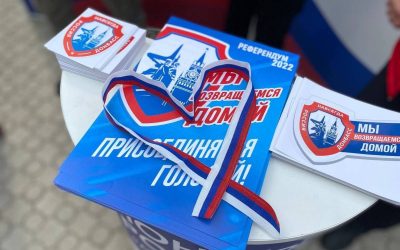Launch of the Referendum on Integration Into the Russian Federation in the Donbass, Zaporozhye and Kherson Regions

All Global Research articles can be read in 51 languages by activating the “Translate Website” drop down menu on the top banner of our home page (Desktop version).
To receive Global Research’s Daily Newsletter (selected articles), click here.
Follow us on Instagram and Twitter and subscribe to our Telegram Channel. Feel free to repost and share widely Global Research articles.
***
23 September 2022 marks the start of the referendum on integration into the Russian Federation in the Donbass (Donetsk and Lugansk People’s Republics), Zaporozhye and Kherson regions. Voting conditions in each region vary depending on the security situation.
On this Friday morning, I join a group of four women who are part of their district’s electoral commission at around 8.30 am. Despite the cold and the pouring rain, they are going door-to-door for 12 hours to allow their fellow citizens to vote for the referendum on integration with the Russian Federation, without leaving their homes.
Equipped with a paper list of voters, ballot papers and a portable sealed ballot box, the four women have four days to visit as many voters as possible. The aim is to minimise the number of voters who will have to go to the polling stations on 27 September 2022 to make their wishes known in the referendum on the integration of the DPR into the Russian Federation.
Because of the daily shelling by the Ukrainian army against the residential areas of Donetsk, Gorlovka and Makeyevka, it would be extremely dangerous if long queues formed in front of the polling stations.
So it is the members of the electoral commissions, volunteers, who take the risk in place of the voters, going from house to house, from building to building, to get people to vote in their homes. And on the first day of this referendum on integration into the Russian Federation, the weather does not make things easy.
But despite the risk of bombing, the rain, the mud and their soaked shoes, the four women I accompany continue their duty, and knock on every door. The procedure is almost the same as in a polling station. The voter shows his passport, his identity is checked, he signs opposite his name in the list, fills in his ballot paper and puts it in the sealed ballot box. In the absence of a polling booth and a suitable place (some people vote on their doorstep), the women I accompany simply look away as the person ticks the box that corresponds to their choice.
See the report filmed on site, with French subtitles:
Other teams, like the one followed by Canadian journalist Eva Bartlett, use a binder as a mini voting booth.
The sealed ballot box will only be opened in the evening, once it has been deposited at the district polling station, thus respecting the procedures aimed at ensuring the reliability of the vote. For those who could not (or did not want to) vote at home, the polling stations will be open on 27 September 2022.
In the DPR, the vote is monitored by 129 foreign observers from Italy, France, Russia, Venezuela, Romania, Togo and South Africa. And no less than 542 journalists from DPR, Russia, the UK, China, France, Italy, Portugal, Venezuela and Qatar are covering the event.
In the Kherson region, the security situation allows the referendum on integration into the Russian Federation to be held in polling stations, as can be seen in the images by Patrick Lancaster.
For my part, it comes as no surprise that all the voters I visited this morning are voting for integration into the Russian Federation, and doing so in an ostensible manner. As one of the women who voted today said: “We are for Russia, we want nothing else”.
Another explained her vote for integration in this referendum as “Russia is those who have not betrayed us, those who help us, those who respect our choice, help us and support us”.
It is clear that the recent bombings of the Ukrainian army against civilians did not discourage people from voting. On the contrary, they have strengthened the will of the Donetsk inhabitants to choose integration with the Russian Federation in this referendum.
*
Note to readers: Please click the share buttons above or below. Follow us on Instagram and Twitter and subscribe to our Telegram Channel. Feel free to repost and share widely Global Research articles.
Featured image is from Donbass Insider

